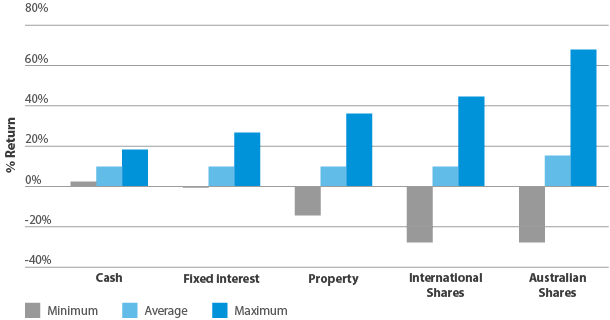Cash: what’s the risk?
Cash. It’s something we are all very familiar with, although we are tending to use it less and less these days, instead preferring credit cards or PayPal or BPay to meet our expenses.
As an investment asset class, cash offers the lowest potential return of all the investment types, but it is also the lowest risk. Cash is commonly referred to as a ‘defensive asset’ because there is greater likelihood of a positive return. You can see this in the chart below which shows the maximum, minimum and average returns over the last 40 financial years to 30 June 2014. This is the case for most of the asset classes we typically invest in for our Ready Made options. Even the lowest or minimum annual return for cash over this entire period has still been positive.
40 year historical performance of asset classes to 30 June 2014

Cash as part of your investments can include things like at call bank deposits, bank bills and term deposits. These are typically short-term investments which are usually invested for less than a year.
While cash can produce an income and protect against negative returns, its capital value does not increase over time and this leaves the investment susceptible to inflation risk. Inflation is the measure of the increase in prices over time. We typically measure inflation using the Consumer Price Index or CPI. Usually a dollar will buy less in the future than it will today. In the example below, you'll need over 30 per cent more money to buy the same basket of goods in 2014 as you did in 2004.

The risk of inflation for investors is that if inflation exceeds your level of investment return, the true value of your investments are eroded over time. Another way to look at it this is that if the rate of interest you receive on your cash investment is lower than the rate of inflation, then the value of your money would not actually be growing in terms of your spending power.
This is the reason why an investment strategy for retirees will typically have exposure to assets that are expected to outperform inflation (this is the case for our Ready Made options such as Balanced, where we aim to deliver CPI+3.5% over the long term to our members). So if you are planning to rely on cash savings to fund your very long-term goals, such as a certain standard of living in retirement, the risk posed by this slow erosion to the power of your savings could be significant.
I would like to leave you with a final thought about the risk of cash – longevity risk. Some people move their entire superannuation savings from options like Balanced into Cash when they retire. While leaving enough money in the Cash option to live off for a short period can be sensible, don’t forget that you need your investments in superannuation to hopefully last you some time into your retirement, which could be 15 or 20 years plus.
While this blog is for general information only, when you make investment decisions I encourage you to think about longevity and inflation risk and the possible length of time you need your investment savings to last, especially when considering transitioning into retirement.
The views of the author and those included in the responses to comments posted on this blog are not necessarily the views of QSuper. This information is for general purposes only. It is not intended to constitute advice and persons should seek professional advice before relying on this information.
Past performance is not a reliable indicator of future performance. Each of our investment options has a different objective, risk profile, and asset allocation.
We are delighted that you have chosen to visit our blog and welcome your comments. Please see our Community guidelines for our social media house rules.